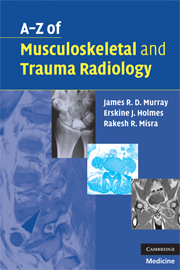Book contents
- Frontmatter
- Contents
- Acknowledgements
- Preface
- List of abbreviations
- Section I Musculoskeletal radiology
- Section II Trauma radiology
- ATLS – Advanced Trauma Life Support
- Acetabular fractures
- Aortic rupture
- Cervical spine injury
- Flail chest
- Haemothorax
- Open fractures
- Pelvic fracture
- Peri-physeal injury
- Pneumothorax
- Rib/sternal fracture
- Skull fracture
- Thoraco-lumbar spine fractures
- Acromioclavicular joint injury
- Carpal dislocation and instability
- Clavicular fractures
- Elbow injuries and distal humeral fractures
- Hand injuries – general principles
- Hand injuries – specific examples
- Thumb metacarpal fractures
- Humerus fracture – proximal fractures
- Humerus fracture – shaft fractures
- Humerus fracture – supracondylar fractures – paediatric
- Radius fracture – head of radius fractures
- Radius fracture – shaft fractures
- Galeazzi fracture dislocation
- Radius fracture – distal radial fractures
- Related wrist fractures
- Scaphoid fracture
- Scapular fracture
- Shoulder dislocation
- Ulna fracture – proximal and olecranon fractures
- Ulna fracture – shaft fractures
- Monteggia fracture dislocation
- Accessory ossicles of the foot
- Ankle fractures
- Bone bruising
- Calcaneal (Os calcis) fractures
- Femoral neck fracture
- Femoral shaft fracture
- Femoral supracondylar fracture
- Hip dislocation – traumatic
- Knee soft-tissue injury
- Metatarsal fractures – commonly fifth MT base
- Patella fracture
- Tibial-plateau fracture
- Tibial-shaft fractures
- Tibial-plafond (Pilon) fractures
- Talus fractures/dislocations
Clavicular fractures
from Section II - Trauma radiology
Published online by Cambridge University Press: 22 August 2009
- Frontmatter
- Contents
- Acknowledgements
- Preface
- List of abbreviations
- Section I Musculoskeletal radiology
- Section II Trauma radiology
- ATLS – Advanced Trauma Life Support
- Acetabular fractures
- Aortic rupture
- Cervical spine injury
- Flail chest
- Haemothorax
- Open fractures
- Pelvic fracture
- Peri-physeal injury
- Pneumothorax
- Rib/sternal fracture
- Skull fracture
- Thoraco-lumbar spine fractures
- Acromioclavicular joint injury
- Carpal dislocation and instability
- Clavicular fractures
- Elbow injuries and distal humeral fractures
- Hand injuries – general principles
- Hand injuries – specific examples
- Thumb metacarpal fractures
- Humerus fracture – proximal fractures
- Humerus fracture – shaft fractures
- Humerus fracture – supracondylar fractures – paediatric
- Radius fracture – head of radius fractures
- Radius fracture – shaft fractures
- Galeazzi fracture dislocation
- Radius fracture – distal radial fractures
- Related wrist fractures
- Scaphoid fracture
- Scapular fracture
- Shoulder dislocation
- Ulna fracture – proximal and olecranon fractures
- Ulna fracture – shaft fractures
- Monteggia fracture dislocation
- Accessory ossicles of the foot
- Ankle fractures
- Bone bruising
- Calcaneal (Os calcis) fractures
- Femoral neck fracture
- Femoral shaft fracture
- Femoral supracondylar fracture
- Hip dislocation – traumatic
- Knee soft-tissue injury
- Metatarsal fractures – commonly fifth MT base
- Patella fracture
- Tibial-plateau fracture
- Tibial-shaft fractures
- Tibial-plafond (Pilon) fractures
- Talus fractures/dislocations
Summary
Characteristics
The majority are caused by direct force to the shoulder, e.g. fall. Less commonly the fracture is secondary to transmitted force from falling onto an outstretched hand.
The most common site is the junction of middle and outer third (80%).
May be associated with a sternoclavicular or acromioclavicular dislocation.
Clinical features
Patients will complain of pain at the site of the fracture and will be reluctant to move their shoulder or arm.
There may be anterior, inferior and medial displacement of the shoulder in mid clavicular fractures due to the action of attached muscles.
A palpable step and fracture crepitus can often be felt.
Rarely these are open injuries.
Occasionally the skin can be tethered on fracture ends; as long as the skin is not jeopardized it is safe to treat this as a closed fracture. The skin usually separates off from the fracture ends, as a sling is applied.
Pressure necrosis of the overlying skin is a rare but serious complication.
Rarely there may be an associated pneumothorax or neurovascular injury.
Radiological features
A single AP view is usually adequate.
Often the fracture line is obvious, although in children a greenstick fracture can be difficult to see, but treat as below and review at 2 weeks will distinguish the fractures.
Beware subtle pneumothorax secondary to a bony fragment.
In a patient with a history of malignancy, or when the history does not support the presence of a traumatic injury, a pathological fracture should be considered.
This may be secondary to recurrent disease but always ask for a history of radiotherapy as radionecrosis can mimic metastasis.
Management
ABCs, assess soft tissues and neurovascular status and immobilise.
[…]
- Type
- Chapter
- Information
- A-Z of Musculoskeletal and Trauma Radiology , pp. 228 - 229Publisher: Cambridge University PressPrint publication year: 2008



